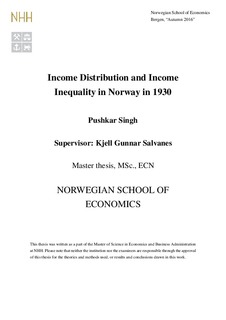Income distribution and income inequality in Norway in 1930
Master thesis
Permanent lenke
http://hdl.handle.net/11250/2432359Utgivelsesdato
2016Metadata
Vis full innførselSamlinger
- CELE - Master thesis [12]
Sammendrag
Income inequality is one of the most widely researched topics in economics. Norway and
other Scandinavian countries are amongst the most equal countries in world and economists
love studying historical inequality in these countries to see whether they were always equal
or inequality decreased over the years. Norwegian economists and especially Rolf Aaberge
have extensively studied income inequality in Norway from late 19th century to present
times using tax records. This thesis studies income distribution and inequality in Norway in
1930 using an extensive unpublished dataset from Statistics Norway archives. The Norwegian
welfare model was started in mid 1930s and hence the period analysed in this thesis is
before Norway embarked on its path of income equality. Interestingly no one has studied
income inequality across Norway in 1930 in detail and hence this thesis fills a gap in current
research.
This thesis uses pre tax income from the tax registries for all tax payers from every kommune
(municipality) in Norway in 1930 to estimate income distribution and inequality. It
shows income distribution for the whole country, for different population subgroups such
men and women, rural and urban areas and important rural and urban kommunes using bar
charts and kernel density estimation. Income inequality for the entire country and subgroups
is calculated using measures such as Gini coefficients and top income shares. Top 1%, 5%,
10% and 50% and bottom 50% income shares among subgroups are compared to find out
how income was divided among top and bottom percentiles in every subgroup. Gini coef-
ficients are used to compare overall inequality among subgroups. Inequality in Norway is
also compared with other Western countries in the period around 1930.
The results show that Norwegian cities were richer and more equal than rural areas in 1930.
Although men were richer than women, there was no big difference in inequality between
men and women. The average Gini coefficient of Norway in 1930 was 0.522, much more
than Norway’s current Gini coefficient. Even though Norway was much more unequal in
1930 than it is today, inequality varied a lot across different parts of the country and population
subgroups. Men living in urban areas were the richest and the most equal subgroup.
Rural women were the poorest subgroup while rural men were the most unequal subgroup.
Urban population was 31% of the entire country and urban areas were richer and more equal
than rural areas. Income distribution also varied across cities and villages and some urban
kommunes like Oslo and rural kommunes like Aker were much richer than other urban and
rural kommunes. Finally, top 1% income share in Norway in 1930 was much less than most
other Western countries while income shares of P 90-99 percentile in Norway and other
Western countries were similar. As a result, Income share of top 1% contributed less to
inequality in Norway as compared to other Western countries.
